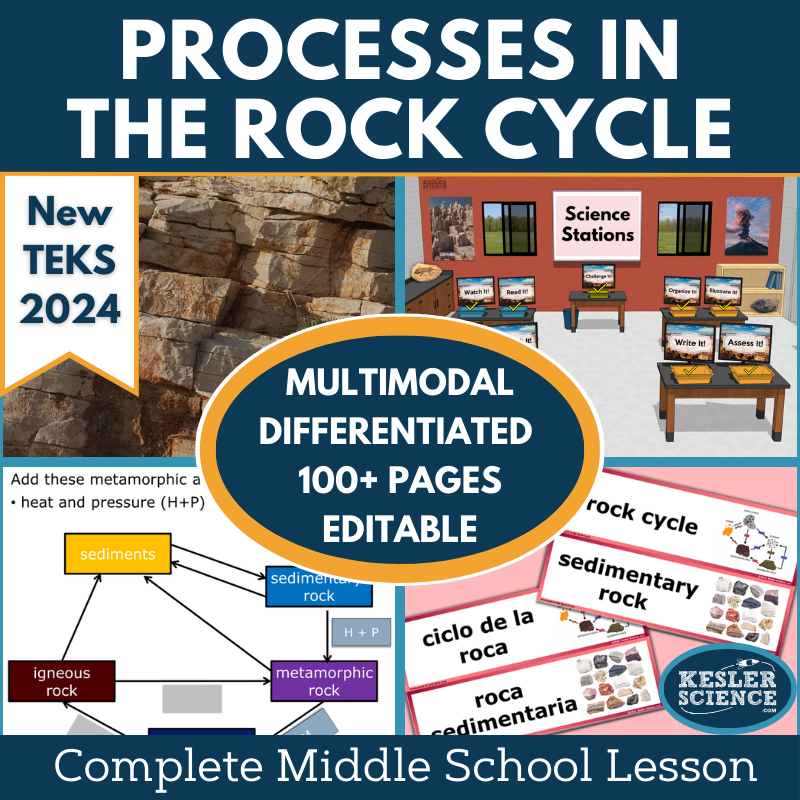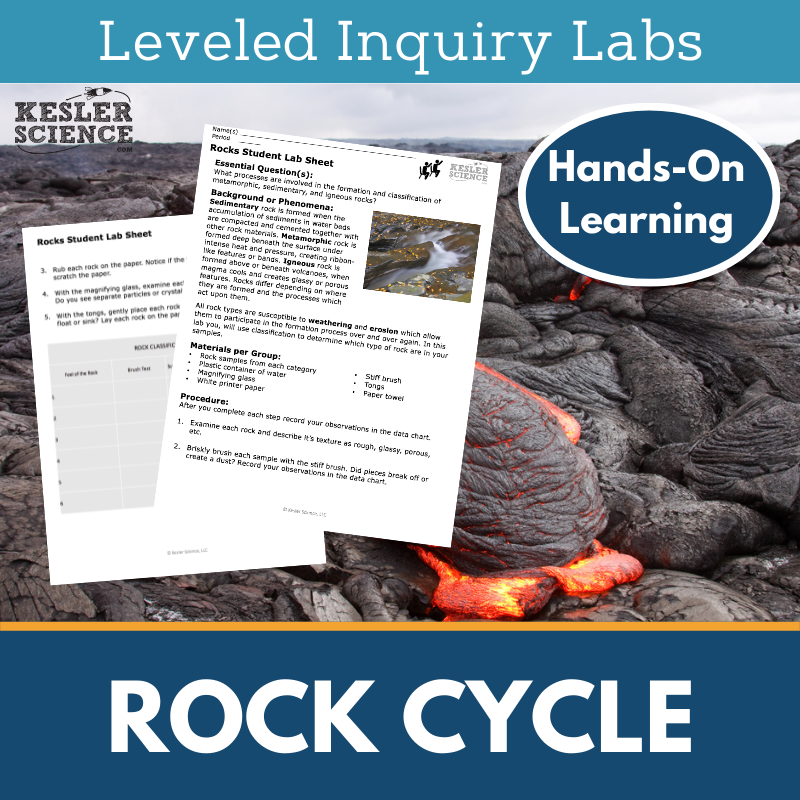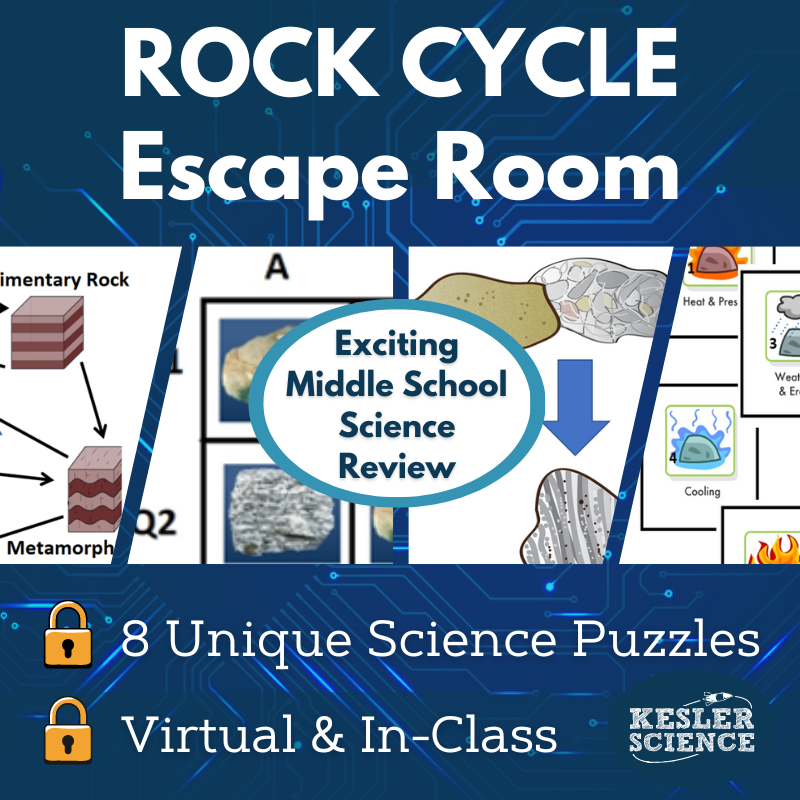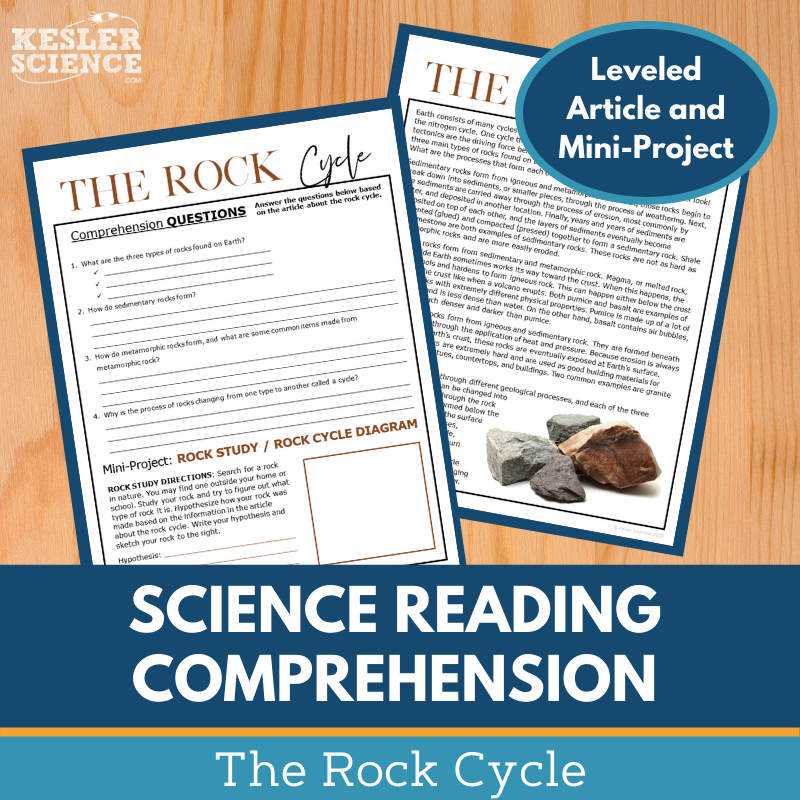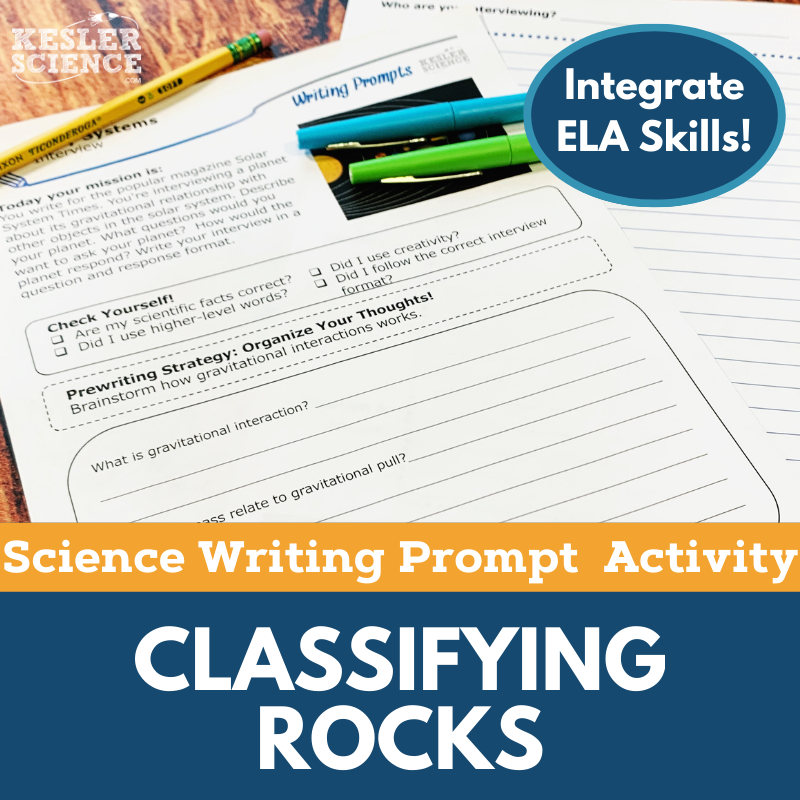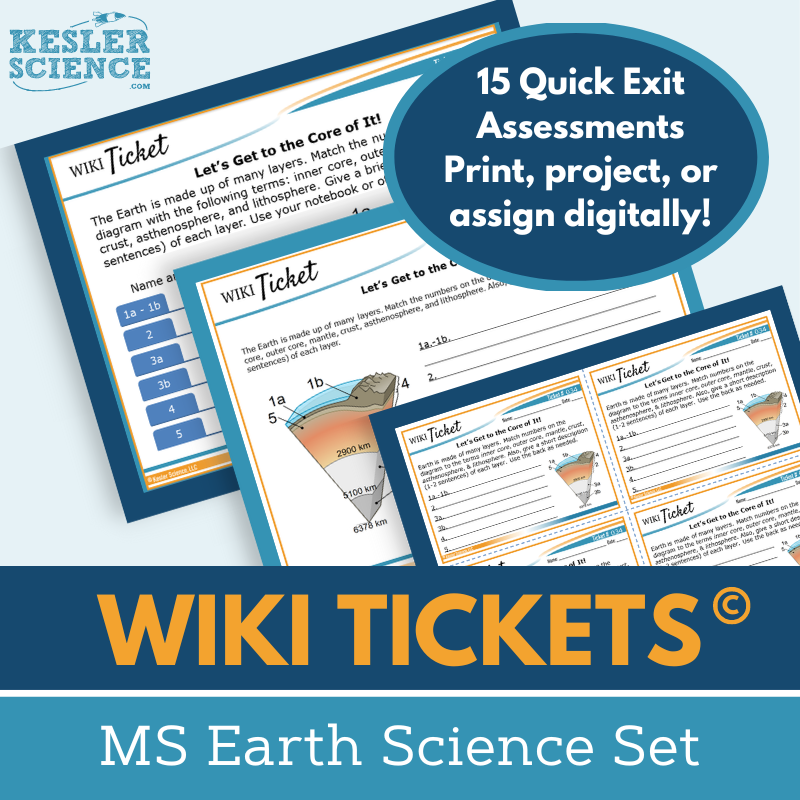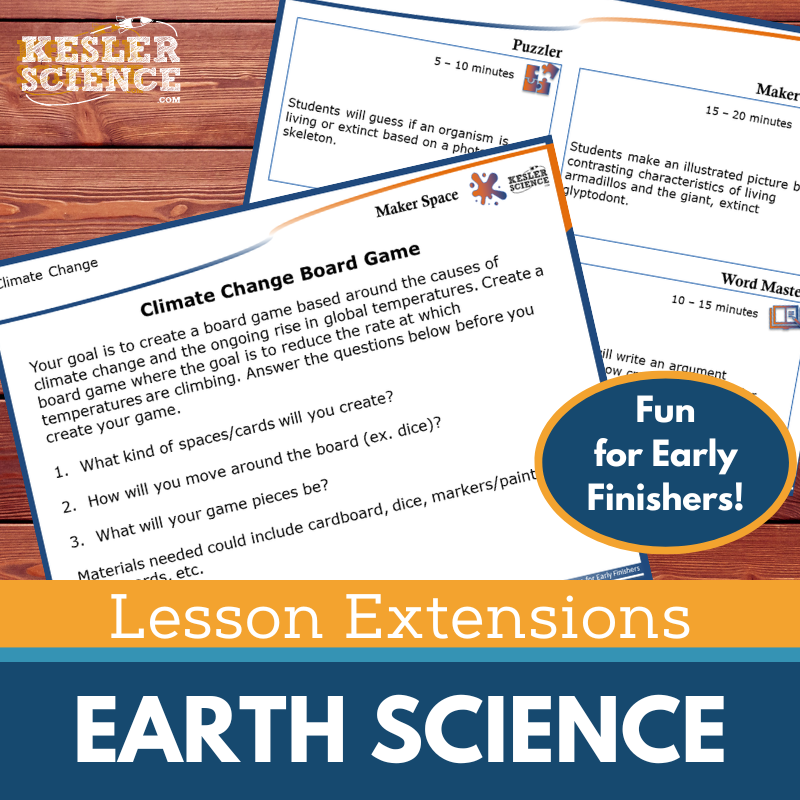Processes in Rock Cycle Activities for Middle School Science
Explore the rock cycle with this engaging 5E lesson designed for middle school students and aligned with TEKS 6.10C. The resources below will give students a comprehensive understanding of the rock cycle. All of the following materials are also included in the Kesler Science Membership.
The Kesler Science Processes in the Rock Cycle 5E Lesson is a comprehensive Earth science unit covering metamorphic, igneous, and sedimentary rock formation and changes through geologic processes. Designed for middle school students, it includes editable presentations, worksheets, choice projects, and assessments, all aligned with TEKS 6.10C. The lesson supports differentiated, student-led learning with low-prep, multimodal resources.
Following the 5E Model, the unit begins with engagement activities, including vocabulary cards and class discussions. In exploration, a hands-on, student-led station lab introduces rock formation and transformation through nine interactive stations, such as hands-on demos, reading passages, research tasks, videos, and creative activities. Explanation features editable PowerPoints, interactive notebooks in English and Spanish, and guided note-taking. Elaboration allows students to extend learning through choice projects, while evaluation includes STAAR 2.0-aligned assessments, worksheets, and review questions.
This lesson is flexible for in-class and virtual learning, with printable and digital formats. Spanish translations of key materials ensure accessibility. The differentiated design keeps students engaged while providing support for varied learning needs.
The Kesler Science Processes in the Rock Cycle 5E Lesson is a comprehensive Earth science unit covering metamorphic, igneous, and sedimentary rock formation and changes through geologic processes. Designed for middle school students, it includes editable presentations, worksheets, choice projects, and assessments, all aligned with TEKS 6.10C. The lesson supports differentiated, student-led learning with low-prep, multimodal resources.
Following the 5E Model, the unit begins with engagement activities, including vocabulary cards and class discussions. In exploration, a hands-on, student-led station lab introduces rock formation and transformation through nine interactive stations, such as hands-on demos, reading passages, research tasks, videos, and creative activities. Explanation features editable PowerPoints, interactive notebooks in English and Spanish, and guided note-taking. Elaboration allows students to extend learning through choice projects, while evaluation includes STAAR 2.0-aligned assessments, worksheets, and review questions.
This lesson is flexible for in-class and virtual learning, with printable and digital formats. Spanish translations of key materials ensure accessibility. The differentiated design keeps students engaged while providing support for varied learning needs.
Engage your students with this modular, student-led station lab aligned with TEKS 6.10C. Designed for in-class or virtual learning, this Earth science lesson guides students in describing how metamorphic, igneous, and sedimentary rocks form and change through geologic processes in the rock cycle.
Students explore these concepts through nine interactive stations featuring videos, readings, research, and hands-on tasks. They demonstrate their learning by organizing information, illustrating models, writing responses, and completing assessments. A bonus challenge station provides extension activities, while differentiated reading passages in English and Spanish support diverse learners.
This low-prep, high-engagement resource fosters active learning and critical thinking.
Engage your students with this modular, student-led station lab aligned with TEKS 6.10C. Designed for in-class or virtual learning, this Earth science lesson guides students in describing how metamorphic, igneous, and sedimentary rocks form and change through geologic processes in the rock cycle.
Students explore these concepts through nine interactive stations featuring videos, readings, research, and hands-on tasks. They demonstrate their learning by organizing information, illustrating models, writing responses, and completing assessments. A bonus challenge station provides extension activities, while differentiated reading passages in English and Spanish support diverse learners.
This low-prep, high-engagement resource fosters active learning and critical thinking.
The Processes in the Rock Cycle Student Choice Projects align with the 2021 TEKS standard 6.10C, giving middle school students the opportunity to choose a project that matches their preferred output style. A project page outlines six student-led options plus a “design your own” project, with an editable rubric for teacher, peer, or self-assessment.
These flexible, multimodal projects allow students to demonstrate their understanding in creative ways. Two versions of the project page support differentiation, with modified options for students needing remediation and challenge options for advanced learners. Teachers can customize the rubric to fit grading needs.
The projects require standard classroom supplies such as paper, markers, and scissors, with many options available for digital completion.
The Processes in the Rock Cycle Student Choice Projects align with the 2021 TEKS standard 6.10C, giving middle school students the opportunity to choose a project that matches their preferred output style. A project page outlines six student-led options plus a “design your own” project, with an editable rubric for teacher, peer, or self-assessment.
These flexible, multimodal projects allow students to demonstrate their understanding in creative ways. Two versions of the project page support differentiation, with modified options for students needing remediation and challenge options for advanced learners. Teachers can customize the rubric to fit grading needs.
The projects require standard classroom supplies such as paper, markers, and scissors, with many options available for digital completion.
The Rock Classification Inquiry Lab aligns with TEKS standards, guiding students in testing and comparing rock samples to classify them as igneous, sedimentary, or metamorphic. Students will explore how each rock's structure relates to its classification and the processes that formed it within the rock cycle.
This resource includes three differentiated labs to support diverse learners. The dependent lab provides structured instructions and guided inquiry, the modified lab offers additional support with sentence stems and multiple-choice questions, and the independent lab encourages student-led exploration with minimal guidance.
Teacher resource pages outline objectives, materials, and instructions, while answer keys and CER reflection questions support assessment. Using common materials like rock samples, a magnifying glass, and a plastic container of water, students engage in a hands-on, inquiry-based learning experience.
The Rock Classification Inquiry Lab aligns with TEKS standards, guiding students in testing and comparing rock samples to classify them as igneous, sedimentary, or metamorphic. Students will explore how each rock's structure relates to its classification and the processes that formed it within the rock cycle.
This resource includes three differentiated labs to support diverse learners. The dependent lab provides structured instructions and guided inquiry, the modified lab offers additional support with sentence stems and multiple-choice questions, and the independent lab encourages student-led exploration with minimal guidance.
Teacher resource pages outline objectives, materials, and instructions, while answer keys and CER reflection questions support assessment. Using common materials like rock samples, a magnifying glass, and a plastic container of water, students engage in a hands-on, inquiry-based learning experience.
The Rock Cycle Escape Room is an interactive activity where students apply their knowledge of the rock cycle, including rock types and processes like weathering, erosion, compaction, cementation, heat and pressure, and cooling.
Teachers have full control over the eight independent puzzles, allowing flexibility in their use based on class time. The activity can be conducted using manila envelopes and passwords or a more immersive setup with locks and a storage box. A digital version is available for individual students via PowerPoint or Google Slides, with a printable option for home use.
The resource includes teacher directions, an answer key, editable templates, a digital answer sheet, and engaging video challenges. Students will enjoy solving puzzles with immersive props, reward templates, and themed signs, making this a memorable, standards-aligned learning experience.
The Rock Cycle Escape Room is an interactive activity where students apply their knowledge of the rock cycle, including rock types and processes like weathering, erosion, compaction, cementation, heat and pressure, and cooling.
Teachers have full control over the eight independent puzzles, allowing flexibility in their use based on class time. The activity can be conducted using manila envelopes and passwords or a more immersive setup with locks and a storage box. A digital version is available for individual students via PowerPoint or Google Slides, with a printable option for home use.
The resource includes teacher directions, an answer key, editable templates, a digital answer sheet, and engaging video challenges. Students will enjoy solving puzzles with immersive props, reward templates, and themed signs, making this a memorable, standards-aligned learning experience.
The Rock Cycle Science Reading Comprehension Lesson helps students explore the processes that form different types of rocks through a nonfiction article, comprehension questions, and a hands-on mini-project. Designed for grades 6-8, with higher-level 5th graders in mind, the leveled passage supports science literacy and reading comprehension.
Students will answer five to seven comprehension questions, create a rock cycle diagram, and write a story about a rock they find. A Cornell notes template is included for additional support. The resource features engaging, colorful graphics that print well in grayscale.
This resource is ideal for sub plans, ISS, extra credit, or whole-class instruction. It can be used in both in-person and virtual learning environments, with files compatible with Google Classroom, MS Teams, Schoology, and Canvas. Students can respond directly within the digital document, making it a versatile tool for building science literacy, fostering discussions, and enhancing textual analysis skills.
The Rock Cycle Science Reading Comprehension Lesson helps students explore the processes that form different types of rocks through a nonfiction article, comprehension questions, and a hands-on mini-project. Designed for grades 6-8, with higher-level 5th graders in mind, the leveled passage supports science literacy and reading comprehension.
Students will answer five to seven comprehension questions, create a rock cycle diagram, and write a story about a rock they find. A Cornell notes template is included for additional support. The resource features engaging, colorful graphics that print well in grayscale.
This resource is ideal for sub plans, ISS, extra credit, or whole-class instruction. It can be used in both in-person and virtual learning environments, with files compatible with Google Classroom, MS Teams, Schoology, and Canvas. Students can respond directly within the digital document, making it a versatile tool for building science literacy, fostering discussions, and enhancing textual analysis skills.
The Classifying Rocks Science Writing Prompt Activity engages middle school students in a compare-and-contrast writing exercise to reinforce their understanding of Earth science. Aligned with TEKS, this activity helps students classify rocks as metamorphic, igneous, or sedimentary based on their formation processes. Designed for both in-person and virtual learning, it enhances science reasoning and writing skills in an engaging, student-centered format.
This resource includes teacher directions with an answer guide, project ideas, and rubrics, as well as projection and print handouts in both full-sized and half-sheet formats. A digital interactive PowerPoint version, compatible with Google Slides, allows for seamless remote learning. It works well as a cross-curricular activity, pre-test assessment, student choice project, or enrichment for early finishers. Additionally, it can be used for extra credit, make-up work, TELPAS samples, or differentiation. This writing prompt fosters creativity and science literacy, making it a valuable addition to any classroom.
The Classifying Rocks Science Writing Prompt Activity engages middle school students in a compare-and-contrast writing exercise to reinforce their understanding of Earth science. Aligned with TEKS, this activity helps students classify rocks as metamorphic, igneous, or sedimentary based on their formation processes. Designed for both in-person and virtual learning, it enhances science reasoning and writing skills in an engaging, student-centered format.
This resource includes teacher directions with an answer guide, project ideas, and rubrics, as well as projection and print handouts in both full-sized and half-sheet formats. A digital interactive PowerPoint version, compatible with Google Slides, allows for seamless remote learning. It works well as a cross-curricular activity, pre-test assessment, student choice project, or enrichment for early finishers. Additionally, it can be used for extra credit, make-up work, TELPAS samples, or differentiation. This writing prompt fosters creativity and science literacy, making it a valuable addition to any classroom.
The WIKI Tickets© Earth Science Set provides 15 formative assessments designed for 6th-8th grade science, offering flexible and engaging ways to check student understanding. Each topic includes five formats: a full-screen projection version, three print handout sizes, and a digital interactive version compatible with PowerPoint and Google Slides.
Aligned with NGSS and TEKS standards, these assessments cover key Earth science topics such as ecoregions in Texas, human impact on the environment and natural resources, land and erosion features, Earth’s layers, tectonic plates, plate movement, minerals, the rock cycle, fossil fuels, watersheds, and groundwater. Some topics have multiple tickets, ensuring comprehensive coverage of the standards. A table of contents file is included for easy alignment reference.
WIKI Tickets© can be used in both in-person and virtual learning environments as exit tickets, bellringers, or quick assessments. Students can write responses on paper when projected, complete printed handouts, or use digital copies in a 1:1 or remote setting. These colorful and engaging assessments provide a versatile tool to gauge student progress effectively.
The WIKI Tickets© Earth Science Set provides 15 formative assessments designed for 6th-8th grade science, offering flexible and engaging ways to check student understanding. Each topic includes five formats: a full-screen projection version, three print handout sizes, and a digital interactive version compatible with PowerPoint and Google Slides.
Aligned with NGSS and TEKS standards, these assessments cover key Earth science topics such as ecoregions in Texas, human impact on the environment and natural resources, land and erosion features, Earth’s layers, tectonic plates, plate movement, minerals, the rock cycle, fossil fuels, watersheds, and groundwater. Some topics have multiple tickets, ensuring comprehensive coverage of the standards. A table of contents file is included for easy alignment reference.
WIKI Tickets© can be used in both in-person and virtual learning environments as exit tickets, bellringers, or quick assessments. Students can write responses on paper when projected, complete printed handouts, or use digital copies in a 1:1 or remote setting. These colorful and engaging assessments provide a versatile tool to gauge student progress effectively.
Lesson Extensions provide engaging, student-choice activities designed to challenge early finishers and deepen their understanding of Earth science standards. These activities help fill downtime, reinforce critical thinking, and keep students engaged with rigorous yet enjoyable learning opportunities. Aligned to NGSS and TEKS, they support independent learning and enrichment.
Each extension includes four interactive components: Puzzler for problem-solving, Maker Space for hands-on STEAM activities, Tech Connection for digital demonstrations, and Word Master for creative writing. With teacher directions, answer keys, and both print and projection versions, these extensions are perfect for lesson wrap-ups, enrichment, or independent challenges.
Topics covered include circulation and climate, climate change, Earth's changing surface, tectonic plates, the fossil record, and more. These extensions ensure students remain engaged while exploring key earth science concepts at a deeper level.
Lesson Extensions provide engaging, student-choice activities designed to challenge early finishers and deepen their understanding of Earth science standards. These activities help fill downtime, reinforce critical thinking, and keep students engaged with rigorous yet enjoyable learning opportunities. Aligned to NGSS and TEKS, they support independent learning and enrichment.
Each extension includes four interactive components: Puzzler for problem-solving, Maker Space for hands-on STEAM activities, Tech Connection for digital demonstrations, and Word Master for creative writing. With teacher directions, answer keys, and both print and projection versions, these extensions are perfect for lesson wrap-ups, enrichment, or independent challenges.
Topics covered include circulation and climate, climate change, Earth's changing surface, tectonic plates, the fossil record, and more. These extensions ensure students remain engaged while exploring key earth science concepts at a deeper level.
This Amazing Anchors Phenomenon Lesson engages students in the rock cycle through the real-world example of the Wave, a rock formation in Arizona. It includes an introductory reading with comprehension and extension questions to build background knowledge, followed by an explanatory reading that simplifies the science behind the rock cycle with reinforcement questions to deepen understanding.
Aligned with TEKS, this no-prep resource includes teacher directions, answer keys, projection slides, and both print and digital formats for Google Classroom and other LMS platforms. A differentiated version provides sentence starters for student support. Designed to bookend a lesson, these engaging readings serve as supplements to reinforce learning in any in-person or virtual classroom.
This Amazing Anchors Phenomenon Lesson engages students in the rock cycle through the real-world example of the Wave, a rock formation in Arizona. It includes an introductory reading with comprehension and extension questions to build background knowledge, followed by an explanatory reading that simplifies the science behind the rock cycle with reinforcement questions to deepen understanding.
Aligned with TEKS, this no-prep resource includes teacher directions, answer keys, projection slides, and both print and digital formats for Google Classroom and other LMS platforms. A differentiated version provides sentence starters for student support. Designed to bookend a lesson, these engaging readings serve as supplements to reinforce learning in any in-person or virtual classroom.
Year-Round Resources
These year-round activities will increase your students' understanding of many middle school science topics. All of these activities are also included in the Kesler Science Membership.
Visual Data & Graphing
You're not alone if your students struggle with understanding graphs, charts, and tables. It's a skill that takes an enormous amount of practice. This resource will help students build a strong foundation in analyzing data and creating their own data visualizations.
Bell Ringers and Warm-Ups
These middle school science bell ringers are an excellent way to engage your students as soon as they walk into your classroom. This comprehensive FULL YEAR resource includes everything you need to start off each science class with an interesting warm-up activity.
Review Board Games
Each game board has been carefully designed to keep students engaged. There are 10 different action spaces on each board and dozens of question cards. All of the actions are related to science concepts and keep the students motivated throughout the game.
Each game is ready to play. Simply print out the board and the cards and let the students enjoy reviewing nine different units.
Essential Questions and Standards
Below are the essential questions and standards associated with the lessons and activities included in the atoms unit. This topic is only one of more than 100 middle school science topics included in the Kesler Science Membership.
-
How do we describe how metamorphic, igneous, and sedimentary rocks form?
-
How does each type change through geologic processes in the rock cycle?
-
TEKS Science - 6.10C Processes in the Rock Cycle
Kesler Science Membership
Imagine never having to search for another middle school science lesson again. The membership gives you access to ALL of the Kesler Science products in one place (Yes, including everything above).
Say goodbye to long hours of lesson prep.

